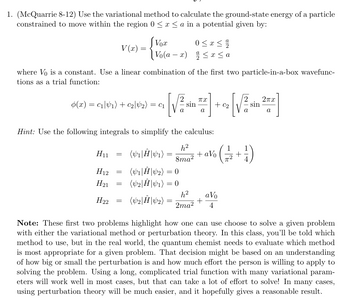
Chemistry
10th Edition
ISBN: 9781305957404
Author: Steven S. Zumdahl, Susan A. Zumdahl, Donald J. DeCoste
Publisher: Cengage Learning
expand_more
expand_more
format_list_bulleted
Question

Transcribed Image Text:1. (McQuarrie 8-12) Use the variational method to calculate the ground-state energy of a particle
constrained to move within the region 0 ≤ x ≤ a in a potential given by:
V(x)
=
Vox
Vo(ax) ≤ x ≤ a
where Vo is a constant. Use a linear combination of the first two particle-in-a-box wavefunc-
tions as a trial function:
(x) = c1|1) + C2|42) = C₁
Пх
Σπα
sin
+ C₂
sin
a
a
a
a
Hint: Use the following integrals to simplify the calculus:
H11 =
(V₁| Ĥ| V₁) =
h²
8ma²
+ aVo
1
-+
H12 =
H21
=
(V1|Ĥ|42) = 0
(V2|Ĥ|41) = 0
H22
=
(V2|Ĥ| V2)
h² a Vo
+
2ma²
4
Note: These first two problems highlight how one can use choose to solve a given problem
with either the variational method or perturbation theory. In this class, you'll be told which
method to use, but in the real world, the quantum chemist needs to evaluate which method
is most appropriate for a given problem. That decision might be based on an understanding
of how big or small the perturbation is and how much effort the person is willing to apply to
solving the problem. Using a long, complicated trial function with many variational param-
eters will work well in most cases, but that can take a lot of effort to solve! In many cases,
using perturbation theory will be much easier, and it hopefully gives a reasonable result.
Expert Solution
This question has been solved!
Explore an expertly crafted, step-by-step solution for a thorough understanding of key concepts.
Step by stepSolved in 2 steps with 3 images

Knowledge Booster
Similar questions
- Evaluate the linear momentum and kinetic energy of a free electron described by the wavefunction e-ikx with k = 5 nm-¹arrow_forwardA Morse oscillator, V(r) = D[1 − e−a(r—ro)]², has D = 164 kJ/mole and w→ ve 1250 cm-1. Compute the energy level (in cm-1) corresponding to the eigenstate shown below. = (Note that the energy units, 11.9627 J/mole = 1 cm-1. It might be helpful to convert the value of D to units of cm-1 before you evaluate the energy level.) wwwarrow_forwardcan you please answer in detailsarrow_forward
- You have a vibrational degree of freedom that can be treated like a harmonic oscillator with a spacing between energy levels of 538,03 cm1, What is the probability that this degree of freedom is in state v = 1 at a temperature of 1,138.2 K. Give your answer with at least 3 significant figures.arrow_forwardConfirm that the wavefunction Y(x,t)= e(px-Et )/h is a solution of the one-dimensional time- 2. dependent Schrödinger equation?arrow_forwardNormalize this two-electron wavefunction a(1) а(2)| |Y(1,2)) : B(1) B(2)|arrow_forward
arrow_back_ios
arrow_forward_ios
Recommended textbooks for you
 ChemistryChemistryISBN:9781305957404Author:Steven S. Zumdahl, Susan A. Zumdahl, Donald J. DeCostePublisher:Cengage Learning
ChemistryChemistryISBN:9781305957404Author:Steven S. Zumdahl, Susan A. Zumdahl, Donald J. DeCostePublisher:Cengage Learning ChemistryChemistryISBN:9781259911156Author:Raymond Chang Dr., Jason Overby ProfessorPublisher:McGraw-Hill Education
ChemistryChemistryISBN:9781259911156Author:Raymond Chang Dr., Jason Overby ProfessorPublisher:McGraw-Hill Education Principles of Instrumental AnalysisChemistryISBN:9781305577213Author:Douglas A. Skoog, F. James Holler, Stanley R. CrouchPublisher:Cengage Learning
Principles of Instrumental AnalysisChemistryISBN:9781305577213Author:Douglas A. Skoog, F. James Holler, Stanley R. CrouchPublisher:Cengage Learning Organic ChemistryChemistryISBN:9780078021558Author:Janice Gorzynski Smith Dr.Publisher:McGraw-Hill Education
Organic ChemistryChemistryISBN:9780078021558Author:Janice Gorzynski Smith Dr.Publisher:McGraw-Hill Education Chemistry: Principles and ReactionsChemistryISBN:9781305079373Author:William L. Masterton, Cecile N. HurleyPublisher:Cengage Learning
Chemistry: Principles and ReactionsChemistryISBN:9781305079373Author:William L. Masterton, Cecile N. HurleyPublisher:Cengage Learning Elementary Principles of Chemical Processes, Bind...ChemistryISBN:9781118431221Author:Richard M. Felder, Ronald W. Rousseau, Lisa G. BullardPublisher:WILEY
Elementary Principles of Chemical Processes, Bind...ChemistryISBN:9781118431221Author:Richard M. Felder, Ronald W. Rousseau, Lisa G. BullardPublisher:WILEY

Chemistry
Chemistry
ISBN:9781305957404
Author:Steven S. Zumdahl, Susan A. Zumdahl, Donald J. DeCoste
Publisher:Cengage Learning

Chemistry
Chemistry
ISBN:9781259911156
Author:Raymond Chang Dr., Jason Overby Professor
Publisher:McGraw-Hill Education

Principles of Instrumental Analysis
Chemistry
ISBN:9781305577213
Author:Douglas A. Skoog, F. James Holler, Stanley R. Crouch
Publisher:Cengage Learning

Organic Chemistry
Chemistry
ISBN:9780078021558
Author:Janice Gorzynski Smith Dr.
Publisher:McGraw-Hill Education

Chemistry: Principles and Reactions
Chemistry
ISBN:9781305079373
Author:William L. Masterton, Cecile N. Hurley
Publisher:Cengage Learning

Elementary Principles of Chemical Processes, Bind...
Chemistry
ISBN:9781118431221
Author:Richard M. Felder, Ronald W. Rousseau, Lisa G. Bullard
Publisher:WILEY